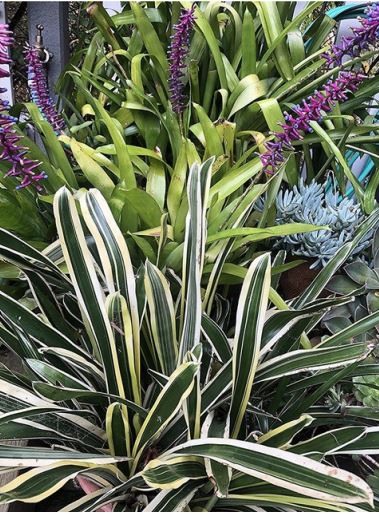June 26th, 2023Glen, about the house…

Bromeliad is a familial name encompassing a somewhat endless plethora of colourful, mostly bullet-proof, house plants – all with their own specific botanical names.
Bromeliads come from North and South America, growing in a great variety of climatic conditions, and each requiring their own special conditions to succeed, whether they belong to the many terrestrial (ground growers) or ephytes (air plants).
Fortunately our climate seems to agree with all but those from the steaming Amazon jungle. But even these are able to deal with our winters if grown in hot house conditions.
Most come from high in the Andes and others from the deserts, meaning their home of choice could be a glasshouse, sunroom, verandah, shady rockery or even full sun. Whatever the requirements, there’s bound to be plenty for your needs. The one pictured above is an example of one of the many of the terrestrial species, aechmea gamosepala.
Early explorers of the New World found they had a ready market with botanical gardens and private collectors, for these and other unusual plants – not to mention those fabulous orchids. This helped with their expenses, so a trained botanist was always a very important member of any expedition. Columbus is credited with taking the pineapple back to Spain after his voyage of discovery.
It was only a matter of fate that the Spanish, orchid-seeking expedition my great grandfather, E.B. Heyne was about to lead, was foiled by a shipboard bout of bubonic plague so he ended up instead, aboard the good ship Godefroi, bound for Melbourne and a role in the establishment of its fledgling botanic gardens. The rest, as they say, is history. A copy of his original plan of the Government House and Royal Botanic Gardens hangs proudly on my study wall.
The aechmeas and similar hard-leafed varieties will do well out of doors in our climate, although the variegated leafed forms will need a little protection from the midday sun, due to minimal chlorophyll in the coloured stripes.
These can be gradually hardened to take outdoor conditions, if given some protection from a shrub or small tree. Like many other similar forms they are also ideal for interior decoration if placed in a well-lit space.
Terrestrial bromeliads do best if left to grow in a compost suitable for orchids with a 1/3 sharp sand added in a well-crocked pot for good drainage. More plants are lost through over-potting, over-feeding and over-watering during cold weather than for any other reason.
The other branch of the bromeliad dynasty are the tillandsioideae. These are perfect ephytes (air plants), which extract moisture through their foliage and use their roots mainly for anchorage on trees. To grow them in containers, use the smallest pot possible to contain the roots and pack them into place with tree fern chunks or peat moss fibre. They need a bush house or glasshouse protection, but will thrive on a
windowsill with indirect sunlight.
In case you hadn’t heard…
Basil was thought to be responsible for breeding scorpions so was avoided to prevent body infestations.
And, if you are ever caught out in a thunderstorm don’t take heed of the 17th century advice that you would never be struck by lightning if you’re standing under a bay tree – highly unlikely anyway in this bay tree-less country.
Finally, if you wish to obtain the favour of great persons, then you should anoint your body with chicory juice. This is so because of the magic associated with this plant, or so it was thought back in 1559.
Got a gardening query? Email glenzgarden@gmail.com









